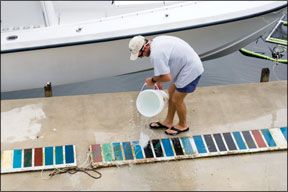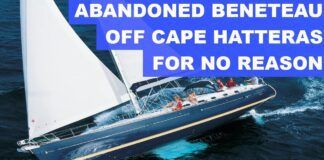If you haven’t bought your bottom paint yet, there still may be time to order some old stock at last year’s prices, but as of early January, when we checked prices for this article, we noticed 10- to 15- percent increases over early 2006 prices.
This month, we have three reports to help make sure your money is well spent. First, we present an update on our Group B panels after six months’ immersion; next, on the facing page, you’ll find a report on our head-to-head tests; and finally, on pages 12 and 13, there’s a look at the best and worst paints from Group A after 18 months. Next month, we’ll look at the results of our freshwater test after six months in Lake Erie.

288
Before diving into the data, you probably want to answer the age old question: “Should I use an ablative or a hard paint?”
Hard paints tend to have a smoother finish that better resists repeated scrubbing and burnishing, although there are some “hard” ablatives that scrub well. Ablative paints wear away over time, so you don’t get the layer-cake build-up over time that you get with a hard paint. The choice is fundamental, as the two paints are not always compatible.
Ultimately, paints of either type can offer outstanding protection, but we’ve also noted an interesting pattern. Our recent tests show that if you want Excellent-rated protection for six months, you have more ablatives to choose from, but at 18 months, more hard paints offer Good protection. At 12 months, the two types are about even in this regard and you still get great protection from some low-priced paints. For a complete picture, see the results of our most recent tests in the 2006 March and October issues.
The Six-Month Report
Today’s anti-fouling paints may be more effective than ever at keeping the bottom of your boat free of marine growth or very close to it but the increasing number of coatings on the market hasn’t made choosing a paint any easier. In June 2006, we sunk a Practical Sailor-record 66 paint panels. Among those 66 are 11 brand-new names.
Three trends in the bottom-paint market continue to gain momentum: the use of anti-slime additives, the increasing number of paints available in bright or white colors, and finally, a hunt for an environment- (and aluminum-) friendly paint that can match the performance of copper paints. Nearly half of the Group B paints contain a slime-fighting agent. On the white and bright-colors front, Interlux began marketing two more paints Micron Extra and Micron CSC as “bright-colored antifoulings,” a category where Pettit has seen much success with its Vivid line. Meanwhile, perennial contender Sea Hawk has two new copper-free paints, Mission Bay CF and Mission Bay CSF.
The search for a no-copper paint is being driven in part by the rising price of copper. While the average prices went up 10 percent, prices of hard paints, which use more copper than ablative/copolymer types, have increased by 13 percent.
So which paints kept the slime at bay after six months? As of December, two high-end paints, Interlux Micron Optima and Sea Hawk’s new Biocop TF, performed best overall. Best Buy honors went to Pettit Premium for an ablative paint and MarPro SuperKote for a hard coating. Flexdel Aquagard came out as the top water-based paint. But, as you’ll see in our Group A 18-month report, fortunes can change quickly. We’ll see how these winners hold up after six more months in the drink.
HOW WE’RE TESTING
Testers begin with brand-new polyester/fiberglass panels, wash them with a de-waxing solvent, sand them lightly with fine-grit sandpaper, and wash them again with solvent to remove any wax or mold-release agent. We then apply the bottom paints, following the instructions supplied with each paint. Each panel is identified by a series of holes drilled in a simple binary code. The holes withstand the attack of marine growth better than any other marker system. The system also keeps testers impartial, because we don’t refer to the codes until after we’ve evaluated the panels.
All paints were tested in two locales. One set was dropped into a saltwater canal in the Florida Keys (Tavernier, Fla.), the other tied to the docks at a boatyard in eastern Long Island Sound (Groton, Conn.). The panels were submerged in June and were retrieved and rated in December.
Before assigning ratings, testers sluiced the panels with buckets of sea water. Virtually clean panels got an Excellent rating. Good and Fair ratings are relative to the field. Good ratings go to those paints with a minimum of soft growth, and coatings with Fair ratings clearly have allowed more soft growth. Poor ratings are given to panels with hard growth.
Once we have the ratings on paper, editors identify overall winners, as well as the top paints in the various categories, such as ablative, hard, one-season, multi-season, environmentally-friendly, and water-based paints. Most of the Recommended paints scored Good in both locations or a combination of Excellent and Fair. If some similar paints scored equally in both locales, we gave the nod to the lower-priced product.
Unusual circumstances made it tough to come to definitive conclusions regarding 10 paints on our Connecticut panels. A strong coastal storm that hit Long Island Sound in late fall appears to have slung one of the panels so that it was scrubbed clean by the back of another panel. Though we do not expect this to affect future updates, we decided not to rate these paints in the Connecticut test. For the overall scoring of these paints, we used only the Florida results.
A note about prices: Our editors scoured the web to find the lowest prices for each paint. However, we’ve seen some big price changes in recent weeks, so we encourage readers to double-check pricing before buying.
A ROOKIE SEASON
Eight of the 66 paints submerged for the 2006 bottom paint test are new coatings. Two of those Sea Hawk Mission Bay CF (copper free) and Sea Hawk Mission Bay CSF are environmentally friendly ablative/copolymer paints that do not contain copper. Sea Hawk’s Mission Bay CSF earned an Excellent rating in Florida.
Four of the new paints fall in the ablative/copolymer category. Three of those Interlux Epoxycop Ablative, Blue Water Copper Shield 45 Uno, and Pettit Alumacoat SR mustered only Fair ratings. The fourth, Sea Hawk Biocop TF, a multi-season copolymer paint, scored an Excellent in Connecticut and a Good in Florida.
The other two new paints are MarPro SuperKote Gold and Blue Water Coppershield 45 Hard. Both paints earned Good ratings in Florida and Fair in Connecticut. The Coppershield 45 Hard is also sold as MarPro SuperKote Hard, which came out strong in our test, earning Good ratings in both Connecticut and Florida. Only two other hard paints Pettit Super Premium and Interlux VC 17m Extra earned Goods in both locales.
In addition, we have two paints new to this test that are re-branded versions of previously tested paints MarPro Super B-Ablative (Blue Water Coppershield 45) and West Marine FW-21 (Pettit SR-21).
North vs. South
Comparing our six months’ results in 2005 to those in 2006, it appears that the Florida site was more fertile in 2006, while Connecticut was less. There were fewer Excellent scores in Florida compared to 2005 (“The Bottom Paint Report,” March 2006), when Florida notched five top marks. In Connecticut, none of the paints scored Excellent in 2005, but this year, four ablative/copolymer coatings (Interlux Super Ablative, Pettit Premium, Sea Hawk Biocop TF, and Sea Hawk Mission Bay CF) received our highest ratings. Two paints have consistently performed well at the six-month mark in Florida: Interlux Micron Optima and Flexdel Aquagard, both water-based coatings that received the top scores in Florida in the 2005 and 2006 tests. In Connecticut, Sea Hawk Monterey, West Marine CPP, and four Interlux paints Regatta Baltoplate Racing, Bottomkote Aqua, Micron 66, and Micron Optima were consistently Good at the six-month mark in 2005 and 2006.
One surprise in Florida this time around was the “thin-film” Interlux VC 17m Extra, which was still holding off hard growth. In 2005, Interlux’s VC 17m and VC 17m Extra and Pettit’s SR-21 (primarily freshwater paints that weren’t expected to do well in salt water) rated Poor at six months.
CONCLUSIONS
Top honors go to two paints that earned a combination of Excellent and Good ratings in our two locations. Interlux Micron Optima scored an Excellent in Florida and a Good in Connecticut, while Sea Hawk’s Biocop TF racked up an Excellent in Connecticut and a Good in Florida.
Our Budget Buy in the ablative/copolymer paint category is the Sea Bowld Ablative 56, which scored Goods in both Connecticut and Florida. Another good buy in this category is Pettit Premium SSA, which we recommend for its Excellent performance in Connecticut.
For a single-season hard paint, MarPro SuperKote Hard garners the Budget Buy award.
We rated several other paints as Recommended. These paints either scored an Excellent in one location, or were the highest-rated paints in both locations best suited for a specific purpose or preference. For those who want a water-based paint, Flexdel’s Aquagard and Pettit Hydrocoat are good choices. Both scored high and can be had for about $100 per gallon. Blue Water Kolor and Sea Hawk Monterey did equally well, but are more expensive.
If you’re looking for a paint in a bright color, go with either Blue Water Kolor for a multiple season ablative, or Pettit Vivid for a multi-season hard paint.
For painting aluminum or for a copper-free coating, consider Sea Hawk’s new Mission Bay CSF, which was the only environmentally-friendly coating to capture an Excellent rating (in Connecticut).
Finally, for serious racers, Interlux’s Regatta Baltoplate Racing has done consistently well at six months.




































